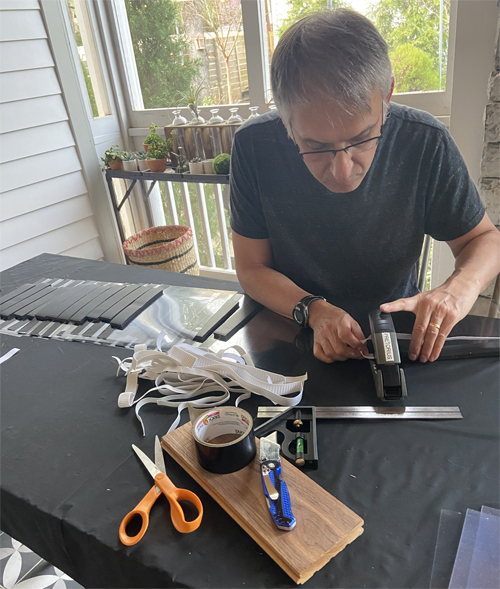by Jill Clendening
As the number of COVID-19 infections continues to grow, Nashville resident Kobie Pretorius was searching for some way to provide meaningful help to others. And she realized her apprehension was spiking each morning as her husband went out the door for work.
She’s married to Mias Pretorius, MBChB, MSCI, chief of Cardiothoracic Anesthesiology at Vanderbilt University Medical Center. His job requires that he intubate and extubate patients during cardiothoracic procedures, so coming in close physical contact with individuals who are or who might be positive for COVID-19 is now all in a day’s work for him and his colleagues.

While VUMC does not have a shortage of personal protective equipment (PPE) and all PPE usage at the Medical Center is being managed judiciously to avert a shortage, Kobie still wanted to do something to ensure all health care providers were protected, no matter what might come in the weeks and months ahead.
And she wasn’t alone in those thoughts. Katy Riojas, a PhD student at the Vanderbilt University School of Engineering, had heard about an effort underway at the University of Wisconsin and University of Wisconsin Hospital to assemble medical face shields using readily available materials. She found the directions online and quickly began putting together prototype face shields.
At the same point, Duke Herrell, MD, a professor of Urology and director of the Minimally-Invasive Urologic Surgery/Robotics Program, contacted his friend and co-collaborator Robert Webster, PhD, Robert A. Schroeder Professor of Mechanical Engineering at VU and suggested they leverage their expertise to find solutions for creating back-up ventilators and PPE for the Medical Center.
Kevin Galloway, research assistant professor of Mechanical Engineering and the director of making at the Wond’ry had already been sketching out ventilator designs while sheltering at home. Galloway, Webster and a team of colleagues and engineering students got busy on the ventilators, ultimately coming up with a functional, open-source design with the goal of producing ventilators locally to be on standby for backup use. They also plan on sharing the design publicly so anyone in the world can replicate it.
Vanderbilt physicians involved in the ventilator project include Duke Herrell, MD; Fabien Maldonado, MD; Erin Gillaspie, MD, MPH; Matthew Bacchetta, MD, MBA, MA; Michael Lester, MD; Arna Banerjee, MD; as well as Craig Rooks, MMHC, administrative director of Respiratory Care at VUMC. Doctoral student Max Emerson, designed the sensor and postdoctoral fellow Joshua Gafford designed the ventilator controls
When Herrell learned of Riojas’ efforts to create face shields, he and Robert Labadie, MD, PhD, professor of Biomedical Engineering and Otolaryngology-Head and Neck Surgery, mobilized to support her efforts.
Medical staff wear face shields over N95 face masks while treating patients to protect against airborne respiratory droplets that can transmit the novel coronavirus. Face shields can be thoroughly disinfected between patients and reused, but they must to be replaced due to wear and tear. While the DIY face shields are not approved for use in operating rooms or critical care settings, they can be used by providers during other clinical visits, helping reserve the OR-approved face shields for critical care and OR use.
The face shields are created using clear plastic binder covers, foam window seal and elastic tape. Using duct tape, scissors or a box cutter, and a stapler to assemble the parts, a shield can be completed in just minutes. This is much quicker than designs using 3-D printing technology, Herrell pointed out.
Herrell went to a major office supply store and a home improvement store to load up on needed supplies. He and his family began making the shields and were soon joined by the Pretorius family; the family of Galen Perdikis, MD, chief of the Department of Plastic Surgery; and the family of Frederick Lombard, MBChB, associate professor of Cardiothoracic Anesthesiology. Friends of the VUMC faculty have also helped by donating materials.
Those involved in the face shield construction project had materials dropped at their doorsteps with no direct contact, surfaces used for assembly were covered and cleaned thoroughly and all hands and tools were thoroughly disinfected. After shields were assembled, they were wiped down with disinfectant wipes.
Hundreds of the face shields have already been delivered to VUMC, and the assembly line crews are awaiting new shipments of elastic to construct more. Their goal is to create at least 3,500 back-up face shields. And while VUMC does not in any way have a shortage of shields or any other PPE, Kobie said it made her feel good to be doing something that might help if shortages were to occur later.
“We know VUMC is doing everything possible to be prepared for the worst-case scenario,” Kobie said. “I think our effort for the Medical Center is covered for now, so we don’t need others making the shields, but a lot of friends around the world found the instructions very useful.
“Friends of ours in South Africa think they can start making these there, and another friend sent instructions to her fellow physician friends in Romania! Friends working at other hospitals around Nashville and throughout the United States have also reached out for detailed instructions.”












